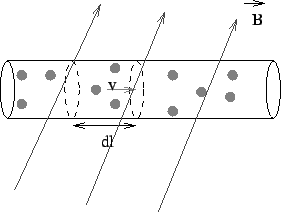SKEDSOFT
Force on a Current Carrying Conductor: A conductor has free electrons which can move in the presence of a field. Since a magnetic field exerts a force ![]() on a charge moving with a velocity
on a charge moving with a velocity ![]() , it also exerts a force on a conductor carrying a current.
, it also exerts a force on a conductor carrying a current.
Consider a conducting wire carrying a current ![]() . The current density at any point in the wire is given by'
. The current density at any point in the wire is given by'
where  is the number density of electrons having a charge
is the number density of electrons having a charge  each and
each and  is the average drift velocity at that point.
is the average drift velocity at that point.
Consider a section of length  of the wire. If
of the wire. If  is the cross sectional area of the section oriented perpendicular to the direction of
is the cross sectional area of the section oriented perpendicular to the direction of  , the force on the electrons in this section is
, the force on the electrons in this section is

where  is the amount of charge in the section
is the amount of charge in the section

Thus the force on the conductor in this section is ![]()
If ![]() represents a vector whose magnitude is the length of the segment and whose direction is along the direction of
represents a vector whose magnitude is the length of the segment and whose direction is along the direction of ![]() , we may rewrite the above as
, we may rewrite the above as

The net force on the conductor is given by summing over all the length elements. If ![]() denotes a unit vector in the direction of the current, then
denotes a unit vector in the direction of the current, then ![]()